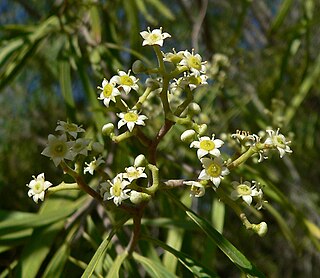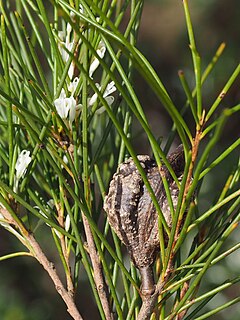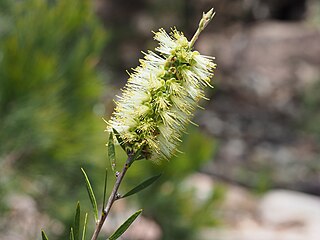
Acacia ligulata is a species of Acacia, a dense shrub widespread in all states of mainland Australia. It is not considered rare or endangered.

Isopogon dawsonii, commonly known as the Nepean conebush, is a shrub of the family Proteaceae and is endemic eastern to New South Wales. It has pinnate leaves with narrow segments and spherical heads of creamy yellow to greyish white flowers.

Myoporum insulare, commonly known as common boobialla, native juniper, is a species of flowering plant in the figwort family Scrophulariaceae and is endemic to coastal areas of Australia. It is a shrub or small tree which grows on dunes and coastal cliffs, is very salt tolerant and widely used in horticulture.

Olearia phlogopappa commonly known as the dusty daisy-bush or alpine daisy-bush is a species of flowering plant in the family Asteraceae that is commonly found in eastern New South Wales, Victoria and Tasmania. It is a small shrub with greyish-green foliage, daisy-like flowers in white, pink or mauve that can be seen from spring to late summer.

Darwinia glaucophylla is a plant in the myrtle family Myrtaceae which grows as a prostrate shrub, sometimes forming extensive mats. It has bluish green leaves and white flowers in small groups which fade to reddish pink as they age. It is only known from about fifteen sites in the Gosford area and is listed as "threatened" in New South Wales legislation.

Isopogon fletcheri, commonly known as Fletcher's drumsticks, is a species of plant in the family Proteaceae and is endemic to a restricted area in the Blue Mountains of New South Wales. It is a bushy shrub with narrow egg-shaped to narrow lance-shaped leaves with the narrower end towards the base, and top-shaped to egg-shaped heads of yellowish or creamy green flowers.

Persoonia rigida, commonly known as the rigid-, hairy- or stiff geebung, is a species of flowering plant in the family Proteaceae and is endemic to south-eastern Australia. It is an erect to low-lying shrub with hairy young branchlets, lance-shaped to spatula-shaped leaves that are hairy when young, and yellow flowers borne in groups of up to twenty on a rachis up to 90 mm (3.5 in) long that continues to grow after flowering.

Geijera parviflora, commonly known as wilga, is a species of shrub or small tree in the family Rutaceae and is endemic to inland parts of eastern Australia. It has drooping branches, linear to narrow lance-shaped leaves, small white flowers in loose panicles and spherical fruit containing a shiny black seed. Other vernacular names include Australian willow, native willow, sheepbush and dogwood.

Hakea ochroptera is a species of flowering plant in the family Proteaceae and is endemic to a restricted area of New South Wales. It is a shrub with long, needle-shaped leaves and an abundance of cream-white flowers in spring.

Persoonia bargoensis, commonly known as the Bargo geebung, is a species of flowering plant in the family Proteaceae and is endemic to a restricted area of New South Wales. It is an erect shrub with linear to lance-shaped leaves, yellow, tube-shaped flowers and green, pear-shaped fruit.

Melaleuca capitata is a shrub in the myrtle family, Myrtaceae and is endemic to New South Wales. It has scaly bark, a densely foliaged habit and attractive heads of creamy-yellow flowers on the ends of its branches in summer.

Melaleuca flavovirens, commonly known as green bottlebrush is a plant in the myrtle family, Myrtaceae and is endemic to a small area near the New South Wales–Queensland border in Australia. It is a stiff shrub, distinguished by its silvery new growth and spikes of greenish flowers with yellow tips.

Hakea actites, commonly known as the mulloway needle bush or wallum hakea is a shrub or tree of the Proteacea family native to areas in north eastern New South Wales and south eastern Queensland. White nectar rich flowers appear in abundance from late autumn to early spring.

Hakea constablei is a shrub in the Proteacea family native to eastern Australia. A bushy shrub or small tree with a profusion of white or cream flowers in spring.
Hakea fraseri, is a species of shrub or small tree commonly known as the corkwood oak, is a shrub in the family Proteaceae and is endemic to northern New South Wales. It has furrowed bark, pendulous foliage and creamy-white flowers in spring.

Darwinia biflora is a plant in the myrtle family Myrtaceae and is endemic to New South Wales. It is an erect, often straggly shrub with flattened, glabrous leaves, and flowers which are arranged in pairs. The flowers are greenish in colour but each is surrounded by two purple-red bracteoles and have a long yellow-green style projecting out of the flower tube. The species only occurs in the Sydney region in a few places where shale-capped ridges intergrade with Hawkesbury sandstone.

Zieria tuberculata, commonly known as warty zieria, is a plant in the citrus family Rutaceae and is endemic to a small area on the south coast of New South Wales. It is a shrub with warty, hairy branches and leaves and large groups of creamy-white, four-petalled flowers in late winter to spring.

Zieria covenyi, commonly known as the Coveny's zieria, is a plant in the citrus family Rutaceae and is endemic to a small area in the Blue Mountains of New South Wales. It is an erect shrub which multiples asexually from root suckers and has three-part, clover-like leaves and clusters of white to pink flowers with four petals and four stamens.

Epacris calvertiana is a plant of the heath family, Ericaceae and is endemic to New South Wales. It is an erect to diffuse shrub with elliptic to egg-shaped leaves with a sharp-pointed tip and with white, pink or red flowers arranged along the ends of leafy branchlets.

Prostanthera askania, commonly known as tranquility mintbush, is a shrub that is endemic to Australia. It has mostly pale mauve flowers, strongly scented leaves and branches, dull green, toothed egg-shaped leaves and a restricted distribution.





















